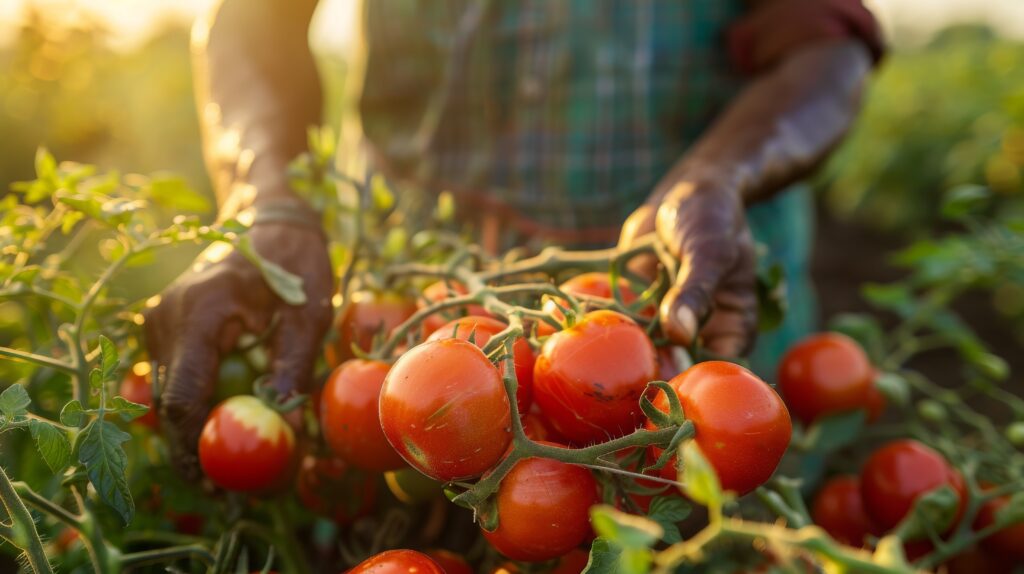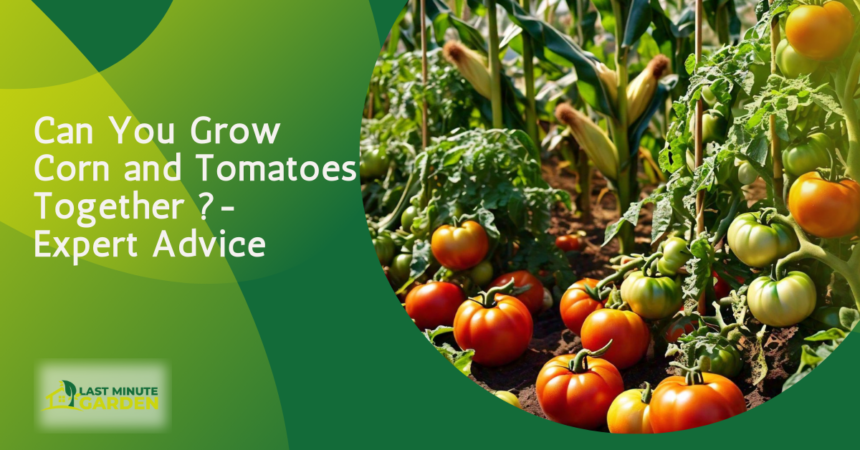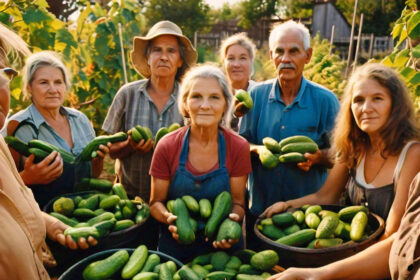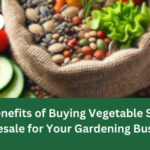Corn and tomatoes love the warm weather and need similar growing conditions. But, can you grow corn and tomatoes together?
This guide will show you how to plant these two crops side by side. You’ll learn about the benefits, challenges, and best practices for making a garden with corn and tomatoes together .
It is perfect for both experienced gardeners and beginners.
Let’s explore this together.
Table of Contents
- Can You Plant Corn and Tomatoes Together?
- Understanding Companion Planting
- Growing Requirements for Corn and Tomatoes
- Shared Pests and Diseases
- Space and Light Considerations
- Soil and Nutrient Needs
- Planting Strategies for Separating Corn and Tomatoes
- Conclusion
Understanding Companion Planting
Companion planting means growing different crops together in one garden spot. This method can help attract pollinators, fix nitrogen in soil, and even protect plants from pests. But, pairing the wrong plants can cause problems like competition for resources and pests spreading.

Benefits of Companion Planting
Companion planting has many benefits for gardeners. Key advantages include:
- Improved pest management by using plants that repel or attract beneficial insects
- Enhanced nutrient cycling and soil health through nitrogen-fixing plants
- Increased biodiversity and support for pollinators
- Mutual physical support or shelter for plants with different growth habits
- Minimized weed growth through the use of cover crops or ground-covering plants
Potential Drawbacks of Incompatible Companions
While companion planting has many benefits, pairing the wrong plants can lead to problems. Some issues include:
- Competition for resources, like water, nutrients, and sunlight, can lower yields.
- The spread of pests and diseases between plants.
- Allelopathic effects, where one plant’s chemicals can slow down another’s growth.
- Incompatible growth habits, like a tall plant shading out a smaller one.
By knowing what each plant needs, gardeners can pick the right companions. This helps avoid these problems.
Companion Planting – Growing Corn and tomatoes together
Corn can grow very tall and might block the sun from reaching tomatoes. This is bad for tomatoes, which need lots of sunlight. Both plants also face the same pests, like the cotton bollworm, which can harm them both.
Corn and tomatoes also need different nutrients. Corn loves nitrogen, while tomatoes prefer other nutrients. This can make it hard to feed both plants well when they’re together.
Potential Challenges in Companion Planting
- Corn’s tall growth can shade and deprive tomato plants of the full sun they need.
- Both crops are susceptible to the cotton bollworm, a common pest that can damage both plants.
- Differing fertilizer requirements of corn and tomatoes can make it difficult to provide the optimal nutrient balance for both.
- Plants from the brassica family, such as cabbage and broccoli, can stunt the growth of tomato plants due to competition for nutrients.
- Fennel and dill can also inhibit the growth of tomato plants when grown in close proximity.
- Potatoes and eggplants, being members of the nightshade family, can compete with tomatoes for nutrients and make them more susceptible to diseases.
Requirements for Growing Corn and Tomatoes together
Planting corn and tomatoes together requires knowing their growing needs. Both love full sun and need about 1-2 inches of water each week. They also prefer soil that drains well and is rich in organic matter.
But, they have different nutritional needs. Corn needs a lot of nitrogen, while tomatoes do better with less. So, it’s important to pay attention to what each plant needs when growing them together.
Corn’s Nitrogen Demands
Corn loves nitrogen and needs a lot of it to grow big and strong. Adding a fertilizer high in nitrogen or compost to the soil before planting helps. This ensures corn gets the nutrients it needs.
Shared Pests and Diseases
Planting corn and tomatoes together can be tricky because they face the same pests, like the cotton bollworm. This pest can harm both crops, making it hard to grow them together without more pests.
The Cotton Bollworm: A Common Threat
The cotton bollworm is a big problem for corn and tomato plants. These larvae eat the leaves, stems, and parts that help the plants grow. This makes it hard to grow corn and tomatoes together in the garden or farm.
Corn and tomatoes can also get diseases from each other when planted close together. These diseases can spread easily. It’s important to plan carefully to avoid these problems.
“Approximately 75% of pests can be managed through companion planting with herbs and other plants in sustainable gardening practices.”
To deal with these issues, gardeners and farmers might use companion planting, crop rotation, and organic pest control. Knowing about pests and diseases helps growers make better choices for a good harvest.
Space and Light Considerations
Growing corn and tomatoes together requires careful thought about space and light. Corn grows tall and can block sunlight from tomatoes. This can stop tomatoes from getting the sun they need. To fix this, make sure to leave enough space between them or grow them in different parts of the garden.
Planting corn and tomatoes in different garden areas helps avoid shading. This way, both plants get enough sunlight for healthy growth and lots of produce. You can also plant them at different times to manage the shade better.
How close you plant the corn and tomatoes matters too. Giving them enough space stops the corn from shading the tomatoes too much. Try different distances to find the best setup for both plants.
Planning where and when to plant corn and tomatoes is key. This ensures that both get space and light. Doing this well boosts your garden’s health and makes your plants grow better together.
Soil and Nutrient Needs
Knowing what corn and tomatoes need to grow well helps gardeners create the best conditions for both. Corn and tomatoes both like similar soil types but need different fertilizers.
Corn needs a lot of nitrogen to grow well. Tomatoes do better with less nitrogen to produce more fruit. With proper soil, water, and nutrients, you can have a great harvest of these summer favorites.
Tomato’s Fertilizer Preferences
Tomatoes do best with a fertilizer that’s low in nitrogen but high in phosphorus and potassium. Too much nitrogen can make them focus on leaves instead of fruit. It’s important to balance the soil’s nutrients when growing tomatoes and corn together.
A special tomato fertilizer or one with more phosphorus and potassium works best for them.

Best Planting Strategies for Separating Corn and Tomatoes
Growing corn and tomatoes together can be tricky. While they can help each other in some ways, they also face challenges when planted together. It’s often better to keep them apart in the garden.
One planting strategy for separating corn and tomatoes is to give each crop its own space. Keeping them in their own space can stop problems like corn earworms or blight from spreading.
This also stops pests and diseases from spreading easily. And also helps them get enough light, water, and nutrients without fighting over them.
Here are some specific guidelines.
- Planting corn and tomatoes in different beds or sections of the garden can help maintain proper spacing and airflow between the crops.
- Using a physical barrier, such as a trellis or row cover, can also create distance between the corn and tomatoes, further reducing the risk of cross-contamination.
- Carefully planning the garden layout to ensure adequate spacing between crops can maximize the productivity and health of both corn and tomatoes.
Conclusion
Corn and tomatoes are both great for summer gardens, but they don’t always grow well together. They might block sunlight, fight for water and nutrients, and share pests and diseases. Gardeners should think about these issues before planting them side by side.
There’s not much science to back up the idea that growing corn and tomatoes together helps. Many gardening tips aren’t based on solid research. It’s important for gardeners to be skeptical and stick to methods that have been proven to work.
In the end, while some plants do better when grown together, it’s key to research their needs and how they interact. This way, you can make smart choices for your garden. Understanding the science behind planting together helps you grow a successful garden.





